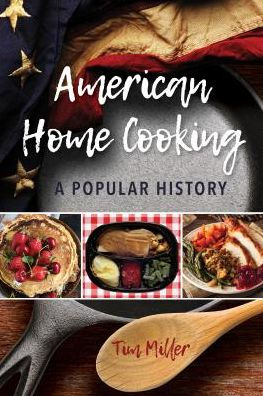American Home Cooking: A Popular History
American Home Cooking provides an answer to the question of why, in the face of all the modern technology we have for saving time, Americans still spend time in their kitchens cooking.Americans eat four to five meals per week in a restaurant and buy millions of dollars’ worth of convenience foods. Cooking, especially from scratch, is clearly on its way out. However, if this is true, why do we spend so much money on kitchen appliances both large and small? Why are so many cooking shows and cookbooks published each year if so few people actually cook?In American Home Cooking, Timothy Miller argues that there are historical reasons behind the reality of American cooking. There are some factors that, over the past two hundred years, have kept us close to our kitchens, while there are other factors that have worked to push us away from our kitchens. At one end of the cooking and eating continuum is preparing meals from scratch: all ingredients are raw and unprocessed and, in extreme cases, grown at the home. On the other end of the spectrum is dining out at a restaurant, where no cooking is done but the family is still fed. All dining experiences exist along this continuum, and Miller considers how American dining has moved along the continuum. He looks at a number of different groups and trends that have affected the state of the American kitchen, stretching back to the early 1800s. These include food and appliance companies, the restaurant industry, the home economics movement of the early 20th century, and reform movements such as the counterculture of the 1960s and the religious reform movements of the 1800s. And yet the kitchen is still, most often, the center of the home and the place where most people expect to cook and eat – even if they don’t.
1125388226
American Home Cooking: A Popular History
American Home Cooking provides an answer to the question of why, in the face of all the modern technology we have for saving time, Americans still spend time in their kitchens cooking.Americans eat four to five meals per week in a restaurant and buy millions of dollars’ worth of convenience foods. Cooking, especially from scratch, is clearly on its way out. However, if this is true, why do we spend so much money on kitchen appliances both large and small? Why are so many cooking shows and cookbooks published each year if so few people actually cook?In American Home Cooking, Timothy Miller argues that there are historical reasons behind the reality of American cooking. There are some factors that, over the past two hundred years, have kept us close to our kitchens, while there are other factors that have worked to push us away from our kitchens. At one end of the cooking and eating continuum is preparing meals from scratch: all ingredients are raw and unprocessed and, in extreme cases, grown at the home. On the other end of the spectrum is dining out at a restaurant, where no cooking is done but the family is still fed. All dining experiences exist along this continuum, and Miller considers how American dining has moved along the continuum. He looks at a number of different groups and trends that have affected the state of the American kitchen, stretching back to the early 1800s. These include food and appliance companies, the restaurant industry, the home economics movement of the early 20th century, and reform movements such as the counterculture of the 1960s and the religious reform movements of the 1800s. And yet the kitchen is still, most often, the center of the home and the place where most people expect to cook and eat – even if they don’t.
51.0
In Stock
5
1

American Home Cooking: A Popular History
210
American Home Cooking: A Popular History
210
51.0
In Stock

Product Details
| ISBN-13: | 9781442253452 |
|---|---|
| Publisher: | Rowman & Littlefield Publishers, Inc. |
| Publication date: | 07/01/2017 |
| Series: | Rowman & Littlefield Studies in Food and Gastronomy |
| Pages: | 210 |
| Product dimensions: | 6.10(w) x 9.10(h) x 0.90(d) |
About the Author
From the B&N Reads Blog
